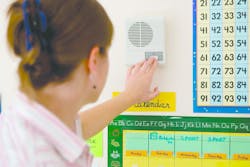Audio intercoms provide cost-efficient security layer for schools
Most people probably remember a school intercom. Each morning speakers in the classroom shared news of assemblies, sports events and deadlines for returning forms — all dispassionately read by the front office receptionist.
But when manmade or natural emergencies strike a K-12 campus, immediate communication between administrators, faculty, staff and students becomes critical. That’s when an audio intercom proves to be one of the most valuable and cost-efficient layers of campus security.
An audio intercom allows office personnel to simultaneously alert each classroom and provide specific commands such as lock in place or evacuate to a safer location. If, for example, the emergency affects a single classroom, such as an agitated non-custodial parent seeking his or her child, the notice can be shared only with that student’s teacher.
Sometimes emergencies originate in the classroom, such as a medical problem or an out-of-control student. In those cases, teachers can use the intercom to page the main office for assistance. If the teacher is interrupted after paging but prior to speaking, office personnel will see which classroom initiated the contact through an LED light on the master station.
By installing master stations in each classroom, individual teachers can make calls to any other classroom or broadcast an announcement to all rooms. This could be important if office personnel are unable to make announcements or if a teacher wants to warn adjacent classrooms about an active shooter’s position without announcing it to the entire campus.
And, unlike a standard telephone, an audio intercom is sender-oriented, meaning that if teacher is using the system an incoming message from the office takes priority.
An audio intercom should become a part of the larger integrated campus security plan. Different units also offer flexible features. For example, an intercom can complement new or existing security cameras, allowing school personnel to see and have two-way conversations with visitors requesting entrance.
Intercoms can also be set up to remotely unlock doors. With many schools keeping classrooms locked from the inside at all times, the office can notify teachers about expected visitors on the way so he or she can unlock the door while staying near the desk. An intercom can also remotely control lighting.
Audio intercoms come in a variety of different form factors, each intended for specific campus uses. In each case, they work through a master station, which is typically located in the main office or security control center.
- Classroom units can be in-wall mounted with a speaker and call button to summon the master station. These units allow hands-free, open-voice conversation that can be heard by anyone in the immediate area. Sometimes conversations should remain private between the teacher and office. Audio intercoms that include a handset can accommodate that.
- A security window intercom permits hands-free communication between visitors and office personnel separated by bullet-resistant glass. This system uses a speaker driver and acoustic tubing to provide communication without compromising the glass’ integrity.
- IP-based intercoms are available to transmit messages wirelessly throughout the campus. This can be helpful when installing a station on an athletic field or other remote campus location. Hardwired units are available if network bandwidth is a concern.
- Call station intercoms are valuable in areas prone to vandalism, theft or violence. Installing them in a playground, cafeteria, library, gym, or locker area, allows teachers, administrators or security personnel a way to immediately speak to and seek help from the front office.
- External weatherproof paging speaker horns alert people outdoors when an emergency strikes. These horns can broadcast in noisy environments where louder amplification is needed and can also be used to help locate personnel.
- Phone-style intercoms can support up to 90 stations, each classroom station be able to dial a two-digit number and communicate with other stations or initiate a page to a single paging zone.
- Easily identifiable rescue assistance stations, good for larger campuses, can offer immediate assistance to students and faculty and help quickly assess emergency situations in remote areas. Audio-only stations are available, but security cameras can be integrated to provide more information to office or security personnel.
There is no doubt that audio intercoms belong on every K-12 campus along with other security layers such as security cameras, access control and visitor management.
But before installing a new or upgrading an existing intercom system, have an experienced school security expert conduct a thorough campus risk assessment. That will identify the type and placement of audio intercom components necessary to cover the campus and be sure it is properly integrated with other security systems. Include use of the intercom in all written emergency plans and make it a part of all regularly conducted emergency drills.
And, or course, remember that audio intercoms are still great for reminding students what’s on the cafeteria lunch menu that day.
About the Author: Patrick V. Fiel, Sr. is an independent security consultant assisting Aiphone Corp., a leading manufacturer of intercommunication and video entry systems– including video intercoms – for the K-12, higher education, industrial/commercial and residential markets. Its North American headquarters is located in Bellevue, Wash. For more information, please visit http://www.aiphone.com.
About the Author

Patrick V. Fiel, Sr.
Former Executive Director of Security for Washington, D.C. Public Schools
Patrick V. Fiel Sr., a national security expert with more than 40 years of experience in law enforcement and security management, is a retired member of the U.S. Army Military Police Corps. He is available to speak on risk assessments, active shooter preparedness and security best practices. He can be reached at (910) 789-4265 or [email protected].
